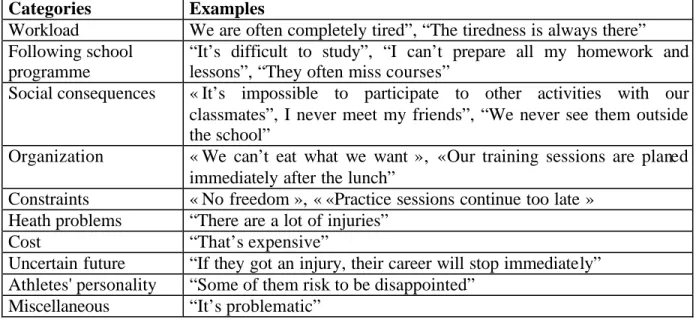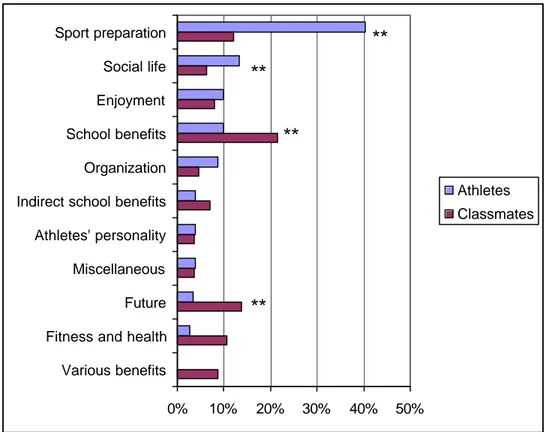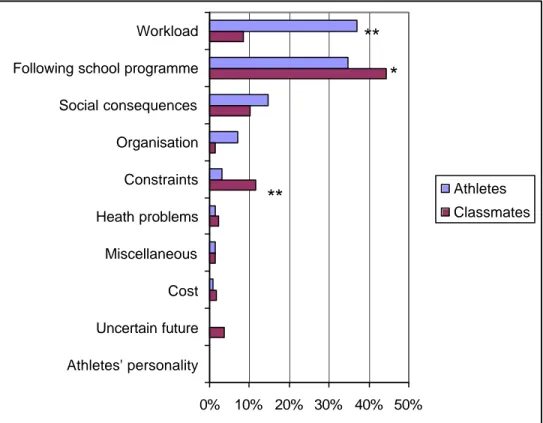Positive and negative aspects of « Sport + Studies Programmes » organized at secondary school level, perceived by athletes and their classmates
Texte intégral
(2) The criteria for success in these “Sport + Studies Programmes” are : (1) availability of a boarding school with specific educators and tutors; (2) schedule adaptation; (3) medical and scientific staff; (4) facilities and equipment; (5) open minded school staff.. The training officers consider usually that “Sports + Studies Programmes” are successful. In Wallonia, the best example of their “products” is indisputably that of Justine Henin, # 4 at the WTA ranking (January, 2003). She followed a programme launched in 1992.. Nevertheless, examples like that are not so frequent. Usual questio ns raised about these programmes could be summarized as followed:. (1) What is their effectiveness in developing of the young athletes performance’s level? (2) Is their school achievement really pursued and observed? (3) Do the young athletes experience difficulties with many aspects of their life (family, social relationships, physical and mental health, …)? (4) What are the reactions and attitudes of their classmates in relation to their particular status?. Few researches were conducted to answer these questions. Deveen (1971, 1974) underlined school problems encountered by top athletes but, paradoxically, he also pointed out that most of them succeeded in their studies. Nevertheless, Pigeassou (1985) showed that the ratio of athletes achieving a secondary school degree was lower than that of non athlete pupils.. Cloes, Schelings, Ledent and Piéron (2002) compared motivational characteristics and social interactions of athletes and their classmates. They pointed out that integrating athletes in a traditional school seemed to produce “ripple” effects on all pupils. Schedules’ modifications and disturbances due to athletes’ absence or behaviour were counterbalanced by creating new dynamics perceived as a developmental element for the school. Young athletes were rather satisfied by their sport performance’s improvement and their positive attitude towards school increased through the school year. Boarding school brought some difficulties to the young athletes: family relationship was missing as well as friends and former clubma tes; lack of leisure was also evidenced. On the opposite, challenge and group spirit. 2.
(3) between athletes and their classmates were positive aspects and supporting the organisation of these programmes.. Methods. This study was part of a research project analysing several aspects of the experience lived by pupils involved in special programmes offering opportunities to good athletes to increase their amount of practice. Within these programmes, athletes followed a schedule allowing them to train regularly during the day without any cut in school hours. They have at least 28 hours of school preparation per week and at least 14 hours of training sessions. In most of cases, programmes were developed in boarding schools and supervisors took care of the pupils in each school. They were appointed by the Ministry of Sport. The coordination between schools, federations and the Ministry of Sport was the key of that organization. To stay within the programme, athletes had to achieve the school requirements.. Fifty-two athletes and 283 classmates from four secondary schools located in Wallonia (French speaking part of Belgium) filled in a questionnaire in November 1999 and in May 2000 (the beginning and the end of the school year). Distribution of subjects is presented in Table 1. All students were 12 to 18-year-old. Principals were interviewed in February 2001 to comment on the results. Athletes practised tennis in Mons, volleyball in Jambes (Namur), soccer, judo, badminton and rugby in two schools in Liège. The tennis school was involved in the programme since 1992 while the other began the experience later. Athletes attended the programme for the first year.. Table 1 – Subjects’ distribution. School. City. Sports. Athletes’ gender Athletes Classmates. 1. Mons. Tennis. Boys – girls. 4. 106. 2. Jambes (Namur). Volley-ball. Girls. 5. 29. 3. Liège. Soccer – Judo – Rugby. Boys > Girls. 36. 129. 4. Liège. Soccer – Judo – Rugby. Boys > Girls. 7. 19. 3.
(4) According to the period of the year and the student’s status, the questionnaires differed slightly (Cloes et al., 2002). Common questions were integrated to compare groups. Two open questions were designed to identify positive and negative aspects perceived by youths concerning the “Sport + Studies Programmes” existing in their school: “List three positive (negative) aspects of the Top Sport programme organised in your school”. They were included in each questionnaire. Answers were classified into categories by identifying key words (Tables 2 and 3). Interanalyst reliability reached 83.2%. Fifty questionnaires were analysed by two researchers. They classified in the same category 79 items out of 95 extracted from the pupils’ answers to the questions dealing with positive and negative aspects of their “Sport + Studies Programme”.. Table 2 – Categories of positive aspects Categories Sport preparation Social life Enjoyment School benefits. Organization Indirect school benefit Athletes’ personality Athletes’ future Fitness and health Various benefits. Miscellaneous. Examples “We can have more training sessions”, “Our improvement is really better”, “They can continue to play” “My family can have a normal life”, “There is a good climate between us”, “We meet top athletes and have many friends” “School days are less difficult”, “ We do what we like”, “They have fun” “It’s possible to continue to study without dropping out for competition”, “They can study and work hard in their sport”, “It’s perfect to complete your studies when you want to compete at a high level” “The training conditions are better than elsewhere”, “The training schedule is favourable” “It’s easier for us”, “Teachers are less demanding with them” “We become more responsible”, “It’s very good for the character” “It’s important for the future”, “They will earn money”, “It’s important for their career” “One stay in good health”, “They are in a good shape”, “They are fit” « Athletes bring something to the school »; « One can be close to well known athletes »; « It’s a good thing for the sport in our country » “It’s good”. 4.
(5) Table 3 - Categories of negative aspects Categories Workload Following school programme Social consequences. Organization Constraints Heath problems Cost Uncertain future Athletes' personality Miscellaneous. Examples We are often completely tired”, “The tiredness is always there” “It’s difficult to study”, “I can’t prepare all my homework and lessons”, “They often miss courses” « It’s impossible to participate to other activities with our classmates”, I never meet my friends”, “We never see them outside the school” « We can’t eat what we want », « Our training sessions are planed immediately after the lunch” « No freedom », « «Practice sessions continue too late » “There are a lot of injuries” “That’s expensive” “If they got an injury, their career will stop immediately” “Some of them risk to be disappointed” “It’s problematic”. Results and discussion. Athletes reported a mean of 2.9 items for positive aspects and 2.5 for negative ones. Classmates were less productive in their answers with, respectively 1.8 and .5 items. They were less concerned by the project. It is noteworthy that there were more positive items then negative ones. That could mean that students were globally satisfied about the “Sport + Studies Programmes”.. Figure 1 provides data concerning positive aspects. Athletes underlined particularly (1) the advantages of the “Sport + Studies Programme” related to the sport preparation (40.4 Vs 12.0 %; z = 7.746; p<.001), and (2) the gains provided in their social life (13.2 Vs 6.2 %; z = 2.635; p = .008). Classmates pointed out (1) the school gains related to the opportunity to combine school and sport (21.4 Vs 9.9 %; z = 3.056; p = .002) and (2) the athletes’ future, a category dealing with the opportunity to start a sport career (13.8 Vs 3.3 %; z = 3.417; p<.001). Athletes paid more attention to positive aspects linked with the sport practice. That seems logical as they gave more importance to sport than classmates (Cloes et al., 2002). The latter seemed more aware of the opportunities provided to athletes to qualify. They also could be influenced by the dream of outstanding careers.. 5.
(6) Sport preparation. **. Social life. **. Enjoyment. **. School benefits Organization. Athletes. Indirect school benefits. Classmates. Athletes' personality Miscellaneous Future. **. Fitness and health Various benefits 0%. 10%. 20%. 30%. 40%. 50%. Figure 1 – Comparison of athletes and classmates positive opinions about the “Sport + Studies Programme” Athletes’ opinion did not change during the year. Nevertheless, at the end of the year, classmates considered that enjoyment and sport preparation were benefits for athletes (2.3≤ z ≤3; p≤.022). The two main categories identified at the beginning of the year were significantly less mentioned (1.9 ≤ z ≤ 2.3; p≤ .055). Classmates could become aware of the sport world realities.. At the beginning of the year, among negative aspects, athletes reported mainly their workload (36.9 %) and the problems met to follow successfully the school programme (34.6 %) (Figure 2). That category ranked first in the negative opinions of classmates (44.3 %). However, they seemed not very aware of the tiredness of young athletes (8.6 %; z = 7.797; p<.001). They gave also more importance to some constraints endured by athletes (less freedom, less free time) (11.5 Vs 3.1 %; z = 2.69; p = .007). Athletes and classmates did not assess the problems in the same way. Teachers and educators should account for differences in classes. Lack of communication could lead to conflict by misunderstanding. Brettschneider et al. (1998) showed that subjective athletes’ perception of the working load increased during secondary school years and that sports activities were the main factor of that evolution. This. 6.
(7) reinforces the need to develop and improve the partnership between schools’ and sports’leaders.. Few changes were observed between the beginning and the end of the school year. Both groups tended to report more social drawbacks as lack of contact within classes.. Principals showed clearly that they were aware of athletes’ opinions. The following extracts of the interviews illustrate clearly that they are aware of what happens in their schools.. Workload. **. Following school programme. *. Social consequences Organisation Constraints. ** Heath problems. Athletes Classmates. Miscellaneous Cost Uncertain future Athletes' personality 0% 10% 20% 30% 40% 50%. Figure 2 – Comparison of athletes and classmates negative opinions about the “Sport + Studies Programme” For school leaders, “Sport + Studies Programmes” are important for talented youth because they are the only way to allow personal improvement without loosing re-orientation opportunities when the talent is not high enough: “…The main thing, it’s to allow talented young people to improve themselves, whatever talent they have. It’s time to school to pay attention to other talents than Latin, mathematics, chemistry, physics,… Nevertheless, we can’t close the doors before eighteen. Then, if one teenager is talented, school must allow. 7.
(8) him/her to improve him/herself without closing doors for later graduation…” (Liège’s coordinator, 2001-02-16).. The emphasis given by athletes to sport preparation was shared by the school leaders: “…It must be highly motivating (to participate to the programme) because they (athletes) meet team-mates and they are the most talented players of each club. They were used to play with their small club faraway and they are now together with athletes of similar level and become a kind of elite. Only the best are selected. It must bring something to them…” (Jambes’ director, 2001-02-23).. Concerning the importance of the category “Enjoyment” in two schools, school leaders tended to qualify the pupils’ opinion: “I don’t know if the pupils (athletes) can really enjoy the programme. They seem glad to be here but in terms of enjoyment…? They are glad about their selection and consider that they are members of an elite…” (Mons’ director, 200102-22).. All interviewed persons mentioned the difficulties encountered by athletes to combine school and sports requirements but they did not seem ready to accept any decreasing the first ones. “Sport + Studies Programmes” do not benefit always to athletes even their life is better organized.. “…At the beginning, many (athletes) consider that school is difficult because they moved from another school to ours. It’s the same when you got another job. It needs adaptation. It’s true that school requirements are important, mainly for the oldest. But, if they want that kind of life which doesn’t sacrify studies, if they want that their diploma would be a real diploma, it’s require fine management, rigor and maturity. The one who is gone beyond, it’s the one who has too much postponed. You must always foresee. You must use each moment, you must steal a march on. School problems exist because we don’t decrease the requirements. Moreover, if we look the achievement’s level of the last year, few of them (athletes) felt or dropped out. Most of them achieved without problem. Definitively, they achieve rather well...” (Liège ’ co-ordinator, 2001-02-16). 8.
(9) “School requirements are rather high considering available time. People think that our school looks for elite level concerning work and school achievement. In the region, the school is considered as the most difficult, the hardest.” (Mons’ director, 2001-02-22). Sport + Studies Programmes” do not solve completely the problem of many young athletes in choosing their way. Those who do not face school difficulties can continue or intensify their practice. Those who need to work hard to achieve have no chance to meet the requirements and must drop out school or sport. Less academic skilled pupils can choose less difficult school programmes and benefit of the sport preparation: “…We accept only very good pupils. At the beginning, I had a file with school marks of each of them (athletes), even if they come from different schools of the country. It’s evident that a pupil reaching only 60% (the minimum to pass is 50%), it would be difficult for her to do both activities because it is evident that they are many training sessions which take time to study time, during the evening. Here, the fact that they are intelligent and work well is a facilitating factor. They need perhaps less time to learn. They are able to manage better their time because they achieve well. Before, they didn’t need to manage their time like that. They have learned quickly. It’s the same with the parents’ control of the homework. Here, they need to work alone…” (Jambes’ director, 2001-02-23). Some adjustments should be made to the actual programmes in helping pupils to be successful at school: modification of the schedule of courses and examinations, distance courses, lengthening of the school year… These practical solutions should rely on new administrative rules and involve government authorities to include these strategies within a national sport policy. It would have many implications because it means changes in human and financial aspects of the society. However, we think that it would be the best way to find a functional organization.. Conclusion. “Sport + Studies Programmes” could be considered as a positive experience. However, improvement s should yet be found to help students in managing the heavy training load. Results showed also that classmates were not aware of the problems perceived by athletes. Practical implications could be drawn from this study to help schools principals in developing new strategies. 9.
(10) In Wallonia, it could be interesting to adapt the legal framework to facilitate the organization of “Sport + Studies Programmes”. Using modified schedules or distance courses should help athletes to increase the amount of training and competitive activities. References Brettschneider, W.-D., Heim, R. & Klimek, G. (1998). Zwischen Schulbank und Sportplatz – Heranwachsende im Spannungsfeld zwischen Schule and Leistungssport. Sportwissenschaft, 28, 1, 27-39. Chevalet, P. (2001). Les Pôles. Sport et études dans le volley-ball français. Proceedings of the Seminar « Volley féminin » organized in Liège, December 22. Brussels: Association Interprovinciale Francophone, 1-7. Cloes, M., Schellings, V., Ledent, M., & Piéron, M. (2002). Sport-études : comparaison des caractéristiques motivationnelles et des relations sociales des élèves sportifs et de leurs condisciples. eJRIEPS (e Journal de la Recherche sur l'Intervention en Éducation Physique et Sport),1. Retrieved February 04, 2003 from the World Wide Web: http://www.fcomte.iufm.fr/recherch/sportetudes.pdf. Deveen, M. (1971). Le sport de haute compétition et les études. Sport, 53, 34-38. Deveen, M. (1974). Réflexions sur la vie sportive et sociale des élites francophones, sélection 1973. Sport, 65, 32-40. Gouvernement du Québec (2002). Secrétariat au loisir et au sport. Programme Sport-études au secondaire, 2000. Protocole d’entente entre une commission scolaire et une fédération sportive québecoise. Retrieved November 15, 2002, from http://www.sls.gouv.qc.ca/sls/pdf/sport/ReglesSportEtude.pdf Pigeassou, C. (1985). L’entraînement sportif dans le système éducatif. Analyse d’une organisation originale: la section sport-études. Thèse de doctorat de troisième cycle, Université de Paris VII. Van Aelst, S. (2000). Topsporters kijgen statuut uitgereikt. Lichamelijke Opvoeding, 4, 2223.. 10.
(11)
Figure




Documents relatifs
By linking two fields of analysis of road safety (fine spatial analysis of crashes and depth analysis of behaviors and psychosocial factors), our project aimed to finely
Additional research is thus needed to identify the various profiles characterizing positive and negative affect intensity and direction in the workplace, their stability over
Relative to the total number of women and men diagnosed with generalized anxiety, depression, or an eating disorder, the occurrence of all 3 of these disorders over the lifetime
In this work, by introducing two crosslink assembly structures with distinct dissociation kinetics in the same polymer network, we design a hybrid hydrogel system
Ailleurs le philosophe n'admet plus de réflexion sur elle-même de la volonté divine globalement prise, et ne se soucie pas des réflexions de la science divine sur
Thus, on the basis of the results of previous studies (Lacassagne et al., 2004, 2006; Mrazek and Schäfer, 1988; Seippel, 2006) content related to health and hedonism should be
De manière générale, plus les élèves sont habitués à sortir dans un cadre bien défini, plus les sorties se déroulent bien, l’ambiance est décontractée et cette relation de
Logistic regression analyses showed that primary school achievements in mathematics and languages were the strongest predictors of failure in secondary school, followed by
